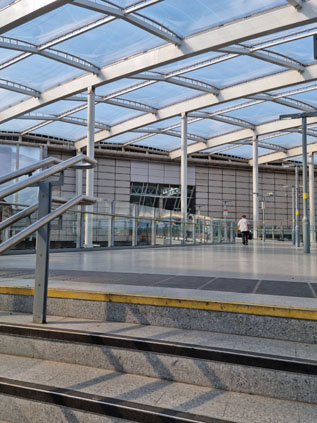The Home Office has published the Government’s response to its Protect Duty public consultation, which ran from February to July 2021. The Home Office has worked on such a proposed Duty, and announced such a consultation, just before the covid pandemic began in spring 2020.
As the Home Office says, such a Duty has been championed by the Martyn’s Law campaign, as set up by Figen Murray in memory of her son, Martyn, who was among those killed in the Manchester Arena suicide bomb terror attack of May 2017. Some 2,755 responses were received; a majority supported the Government’s proposals to introduce stronger measures, including a legal requirement for some public places to ensure preparedness for and protection from terrorist attacks.
Home Secretary Priti Patel said: “My number one priority is keeping the people of the UK safe. Following the tragic attack at the Manchester Arena, we have worked closely with Figen Murray, victims’ groups and partners to develop proposals to improve protective security around the country. I am grateful for their tireless commitment to the duty and those who responded to the consultation; the majority of whom agreed tougher measures are needed to protect the public from harm.
“We will never allow terrorists to restrict our freedoms and way of life, which is why we are committed to bringing forward legislation this year, that will strike the right balance between public safety, whilst not placing excessive burden on small businesses.”
The Home Office was unable to give any timetable of when it would move towards making the Duty into a law, saying only that legislation will be introduced to Parliament at the earliest opportunity.
As for more detail, as to what the Duty should consist of, and who should do what, a good majority of those that responded felt that venue capacity should determine whether a Duty should be applied or not. Most also agreed that venues and organisations owning, operating or responsible for Publicly Accessible Locations (PALs, the new official jargon that previous was ‘crowded places’) should prepare their staff to respond to a terror attack.
All detail remains to be worked out, such as an inspection regime that could punish with fines for non-compliance (some wanted it, some not); and what the Duty should include – a risk assessment, following official guidance, working with police and neighbours and others. Professional Security last year found mixed opinions among the security industry about the value of a Protect Duty; some looking forward to it, some fearing it would be a tick-box affair or that budget necessary for compliance would not be forthcoming. Likewise among the complaints given to the consultation, and acknowledged by the Home Office, was that a Duty would be too much of a burden; to too cumbersome if a venue or site was shared.
As for whether the Duty is actually needed, of those responding who own or operate a Publicly Accessible Location (1,083) some 599 said they did access Government advice on threats, protective security and preparedness – and 484 (45 per cent) said they did not. The two main reasons given for not accessing Government advice and guidance included not knowing it existed, and not thinking they needed to address such a threat.
Pictured: steps from Manchester Victoria station to the Arena.
Comment
Security and safety product company Eaton’s UK and Ireland MD, Siobahn Meikle welcomed the response, and spoke of an opportunity to go even further by making sure legislation encourages individuals and businesses that have a Protect Duty to employ emergency systems that are more adaptive and interconnected so that people are alerted to threats and guided away from them more quickly and safely.
“We know that inaction or the ‘bystander effect’ is a real issue in attacks that happen in high density venues – with some people not responding to alerts. The first 60 seconds of an alert sounding are the most critical because the time it takes for people to recognise a threat is the most variable in an evacuation. In such an event, shortening people’s response to an evacuation or stay put strategy can save lives.
“People respond more quickly when they are given rich information and when a physical reaction is stimulated – for example through live directives telling people about the nature of the threat and pulsating emergency lighting drawing people to safe evacuation points. Animating exit signage and making it as visible as possible is also crucial to help people with hearing disabilities who might otherwise not be able to hear audio directives. Evacuation technologies must work for everyone.
“The interconnected technology exists to adapt to threats in real time – for example to direct people away from routes where incidents have taken place. The safest exit isn’t necessarily the nearest one.
“As any future legislation makes its way through parliament we hope that the opportunity is taken to encourage businesses to implement layered, connected and adaptive emergency systems that will optimise the safety of their venues.”










